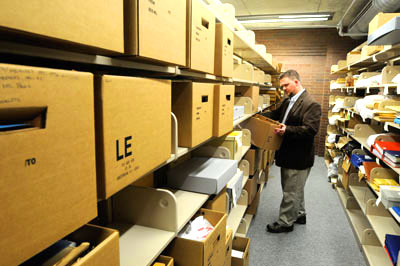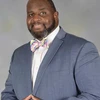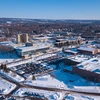
|
The Coalition on West Valley Nuclear Wastes has donated 90 cubic feet of primary documents to the Archives and Special Collections at Reed Library on the SUNY Fredonia campus.
The materials, pertaining to the West Valley Nuclear Demonstration Project, have been collected and maintained over the last four decades by the coalition, an activist group of primarily New York State residents from Cattaraugus and Erie counties.
Currently headed by Judith Einach of Buffalo and Joanne Hameister of East Aurora, the coalition has documented the activities at the West Valley site since it opened in the early 1960s in the Town of Ashford, about 30 miles south of Buffalo. “This collection is the most complete documented history available anywhere about nuclear reprocessing and storage,” said Randy Gadikian, director of library services at SUNY Fredonia.
“It documents the successes, failures and risks that are entailed in operating such a project, and for the first time, this information is available for public review.”
Materials will be preserved and available to researchers around the world
The collection includes national and international government documents, corporate files, coalition meeting minutes, correspondence and comments, campaigns and collected research, and materials from related organizations. While the majority of the materials are papers, the collection also contains audio/ visual materials and artifacts, among other media. The primary goal is to preserve these materials and make them available to researchers at the local, national and international level.
“Our mission has always been to be a watchdog,” said Hameister. “But because we have taken our mission seriously, we are considered a significant stakeholder — and not necessarily an adversarial one — in some of their decision making.”
Where spent nuclear fuel was reprocessed
The West Valley Project was established by the State Office of Atomic Development to commercialize the reprocessing of spent nuclear fuel from power reactors. In 1972 the plant was shut down and radioactive waste was stored underground in steel tanks and unlined burial trenches.
As significant as the collection is, it may now be of even greater relevance following the announcement in early December 2008 of a state-funded study which determined that all of the waste should be removed from the site. The study — the first of its kind to assess the full cost of cleaning up the site — concluded that permanently burying the waste materials on the site would lead to higher long-term costs in addition to the risk of widespread radiation poisoning.
Economists and scientists estimate that the costs to excavate the waste would be $9.9 billion, compared to $13 to $27 billion to leave it buried onsite, depending on whether or not a catastrophic event occurs. One of those scientists is Dr. Michael P. Wilson, a professor of geosciences at SUNY Fredonia who has been providing expert research and testimony relating to this issue since 1986. His research has confirmed the extreme risks and dangers present at the site.
Radioactive for tens of thousands of years
“The nuclear wastes at West Valley will remain radioactive for tens of thousands of years, and will eventually be consumed by erosion and discharged downstream to Lakes Erie and Ontario,” Wilson said. While his research shows that it will likely occur in less than 3,000 years, it is possible, he says, that it could occur in as little as 200 to 300 years. “It would have to be a pretty big leak,” Wilson acknowledges, “but the wrong kind of erosion could produce exactly that.”
“The risks are very real,” Gadakian agrees. “When you consider that about 60 percent of the Canadian population alone is situated in the provinces of Ontario and Quebec — northeast and downstream of West Valley — the potential for a catastrophic event is clearly present. The ability to thoroughly research this topic finally exists, and it exists at SUNY Fredonia.”
SUNY Fredonia’s Archives and Special Collections received a $12,000 grant through the Documentary Heritage Program of the New York State Archives to process the collection. The archives team, which includes contractor Scott Richmond ’04, ’06, ’07, will work to preserve the various document formats, manage the collection and provide access to researchers.
“The coalition’s collection and the West Valley materials are significant to both our region and the world,” Reed Library Archivist Jeremy Linden added. “They also provide a great resource to SUNY Fredonia’s academic mission. The contents are relevant to numerous disciplines across campus, from physics and political science to history and journalism, and offer our students and faculty a unique set of research and educational opportunities.” Prior to their arrival at Reed Library, the documents were located all over Western New York. While much was kept in an East Aurora storage unit, items were also housed in members’ homes.
Future materials will be added to the collection in five year increments to ensure that documentation of the coalition and the West Valley site continues into the future.



